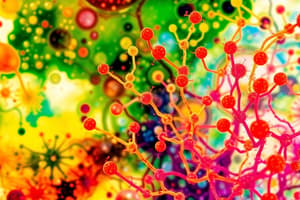Podcast
Questions and Answers
What are the essential factors that must be controlled during the cultivation of microorganisms?
What are the essential factors that must be controlled during the cultivation of microorganisms?
Nutrients, pH, temperature, aeration, salt concentration, and ionic strength of the medium must be controlled.
What are the three major mechanisms for generating metabolic energy in microorganisms?
What are the three major mechanisms for generating metabolic energy in microorganisms?
Fermentation, respiration, and photosynthesis are the three major mechanisms.
Why is isolation of microorganisms in pure culture important?
Why is isolation of microorganisms in pure culture important?
Isolation allows for the study of a specific organism without contamination from others, enabling accurate research and application.
Describe the plating method used for isolating microorganisms.
Describe the plating method used for isolating microorganisms.
What is the purpose of the dilution method in microbial cultivation?
What is the purpose of the dilution method in microbial cultivation?
How does the natural environment impact the population of microorganisms?
How does the natural environment impact the population of microorganisms?
What is a fundamental goal in the cultivation of microorganisms?
What is a fundamental goal in the cultivation of microorganisms?
What role do macromolecules play in the cultivation of microorganisms?
What role do macromolecules play in the cultivation of microorganisms?
What determines the survival of microbial groups within their environment?
What determines the survival of microbial groups within their environment?
What does growth in unicellular microorganisms involve?
What does growth in unicellular microorganisms involve?
Describe the lag phase of bacterial growth.
Describe the lag phase of bacterial growth.
What occurs during the exponential phase of bacterial growth?
What occurs during the exponential phase of bacterial growth?
What happens during the maximum stationary phase?
What happens during the maximum stationary phase?
Explain the decline or death phase in the bacterial growth curve.
Explain the decline or death phase in the bacterial growth curve.
How can cells in the exponential phase be maintained?
How can cells in the exponential phase be maintained?
What key processes occur during the exponential phase of growth?
What key processes occur during the exponential phase of growth?
Flashcards
Microorganism Cultivation
Microorganism Cultivation
The process of growing organisms by providing the right conditions for them to thrive.
Metabolic Energy
Metabolic Energy
Energy needed by organisms to build molecules and maintain cell functions.
Nutrients
Nutrients
Substances needed by organisms to build structures and grow.
Environmental Factors
Environmental Factors
Signup and view all the flashcards
Energy Generation Methods
Energy Generation Methods
Signup and view all the flashcards
Pure Culture Isolation
Pure Culture Isolation
Signup and view all the flashcards
Agar
Agar
Signup and view all the flashcards
Plating Method
Plating Method
Signup and view all the flashcards
Lag Phase
Lag Phase
Signup and view all the flashcards
Exponential Phase
Exponential Phase
Signup and view all the flashcards
Stationary Phase
Stationary Phase
Signup and view all the flashcards
Decline/Death Phase
Decline/Death Phase
Signup and view all the flashcards
Maintaining Exponential Phase
Maintaining Exponential Phase
Signup and view all the flashcards
Generation Time
Generation Time
Signup and view all the flashcards
Microbial Survival
Microbial Survival
Signup and view all the flashcards
Growth of Microorganisms
Growth of Microorganisms
Signup and view all the flashcards
Study Notes
Cultivation of Microorganisms
- Cultivation is the process of growing organisms by providing suitable environmental conditions.
- Organisms need energy (e.g., metabolic energy) to synthesize molecules and maintain chemical gradients across their membranes.
- They also require nutrients in accessible forms.
- Factors like nutrients, pH, temperature, aeration, salt concentration, and ionic strength of the medium need to be controlled.
- Essential metabolic energy is generated through fermentation, respiration, or photosynthesis.
- Cultivation methods involve choosing a suitable medium and isolating a pure bacterial culture.
Fundamental Goals in Microbial Cultivation
- Raising a culture of a specific species.
- Determining the quantity and type of organisms in a sample.
- Isolating a specific organism from a natural source.
Isolation of Microorganisms in Pure Culture
- A single cell needs to be isolated and cultivated to ensure all progeny are isolated as well.
- Several methods are used, including plating methods and dilution methods to achieve this.
Plating Method
- If a small number of cells are placed on a gelled medium (e.g., agar), each cell will develop into a distinct colony.
- Agar is a suitable gelling agent for most microbe media.
- Agar is an acidic polysaccharide extracted from red algae.
Dilution Method
- The dilution method reduces the density of microorganisms in a sample via serial dilutions.
- Diluted samples can be plated or inoculated.
- The method isolates single cells, ensuring each grows into a pure colony.
- Suspensions are serially diluted, and samples are plated or streaked on solid media.
Survival of Microorganisms in Nature
- Microbial populations in the biosphere tend to remain relatively constant.
- Growth is counterbalanced by death.
- Microbial survival depends on maintaining a living population pool and successful competition for resources.
Meaning of Growth
- Growth involves an increase in an organism's size or mass.
- In single-celled microorganisms, this means an increase in the number of individual organisms in the population.
The Bacterial Growth Curve
- The growth curve displays the population dynamics of bacteria in a closed system.
- Distinct phases exist (Lag Phase, Log/Exponential Phase, Stationary Phase, Death Phase).
- The curve describes changes in the number of living cells over time, given a fixed amount of nutrients and environmental conditions.
The Lag Phase
- Bacteria adapt to the new environment and prepare for division.
- There's little to no cell division happening during this phase, but metabolic activity increases.
- Duration is dependent on factors like nutrient availability and organism type.
The Exponential Phase (Log Phase)
- Cells divide at a constant rate, generating exponential population growth.
- Each cell generation time doubles the population size.
- Bacteria are highly sensitive to environmental changes and antibiotics during this phase.
The Stationary Phase
- Growth rate slows as nutrient depletion and waste accumulation occur.
- The number of new cells equals the number of dying cells, leading to a stable population size.
- Metabolic adjustments occur.
The Death (Decline) Phase
- Nutrients are depleted.
- Toxic waste products accumulate, causing an increase in dead cells.
- Cells die at an exponential rate, and some can form spores or remain dormant.
- Cellular structures break down.
Studying That Suits You
Use AI to generate personalized quizzes and flashcards to suit your learning preferences.




